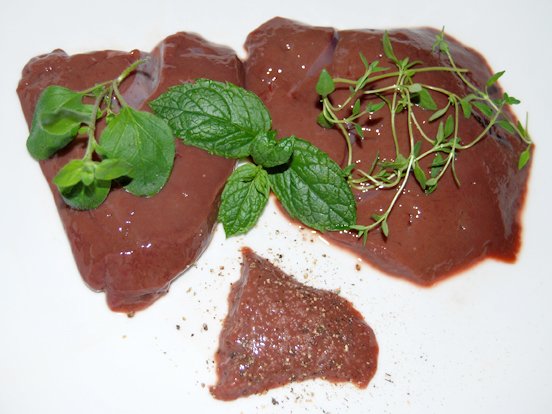Superfood 1/10 Liver [English]
Dear reader,
I would like to start a series here and introduce 10 non-exotic foods (from the point of view of Germany), which can help to get fitter, healthier and more efficient.
Important, this font is for informational purposes only and does not constitute a recommendation or medical advice. The author assumes no liability or responsibility for any damages resulting from any methods used and therefore is not liable.
Liver

In the chapter on algae (to be published later), you will learn, among other things, that algae contains a substance that stores itself in the fatty tissue and then metabolically "reprograms" it.
This reprogramming is nothing more than, well, epigenetics. You make sure that some genes are turned off and other genes shut down.
Our white adipose tissue, which is usually used to store excess fat and leave it on demand, is also available in a "beige" version.
This brownish color is due to the fact that in this fatty tissue mitochondria are increasingly formed, the power plants of our cells. The mitochondria contain iron complexes, which is why the color of the tissue changes accordingly (we know that - keyword rust). Mitochondria in turn burn off many fatty acids. That is why this brownish ("beige") adipose tissue behaves more like a muscle.
The reason why the fatty tissue forms more mitochondria is not the same as in muscle. First and foremost, the muscle builds many mitochondria so that we can move, which consumes a lot of energy. The brown or beige adipose tissue, on the other hand, builds mitochondria to produce heat.
Here comes a clever trick of nature into play:
In the mitochondrion, that for example, if you want to use fat (or other calories) to create heat, you can find a very specific protein called uncoupling protein.
So in order for the adipose tissue to become metabolically active, we can burn fat to generate heat, mitochondria need to be formed and, most importantly, this uncoupling protein must be made.
Mitochondria in adipose tissue can be rapidly multiplied. A little stress or sport and already ... well. The sticking point is the uncoupling protein. And this protein is controlled by the designated master regulator called retinoic acid.
Retinoic acid is a hormone (!) that is made from Vitamin A. The concentration in the body depends directly on the amount of Vitamin A that we feed the body.
Unfortunately we are all very poorly supplied. This starts with the requirement of companies to eat 3000 IU daily, leading to the fact that the vegetable Vitamin A precursor is not enough and ends with us not having the hang of traditional food. Because: My grandmother (and Co.) used to slaughter and, of course, also used the animal's liver.
The liver is a sanctuary in almost all primitive peoples. From a nutritional point of view, it is a multivitamin of nature, full of almost all vitamins and trace elements (iron, copper, zinc and so on).
The liver contains Vitamin A highly concentrated, about 50,000 IU per 100g!
Suppose we only eat 150g of liver per week... That would give us (on average) about 10,000 IU of Vitamin A per day. And that would be a great start.
If you fill your Vitamin A storage tank, you may even feel the body warming up again, especially the fatty tissue.
But that's not all:
What I have experienced myself has meanwhile been experienced and reported by many of my friends and acquaintances: The skin changes drastically, becomes as tender as a baby's bottom. Thus, the skin also serves as an indicator of how well we are supplied with vitamin A.
But Vitamin A can do so much more:
- Retinoic acid needs the cell to be neatly differentiated, that is, to mature properly and not to become a cancerous cell. Therefore, retinoic acid is sometimes used in cancer therapy - as a medical, of course.
- Retinoic acid regulates the immune system. It strengthens immune cells by allowing the formation of strong, antibacterial peptides.
- At the same time, various models have shown that retinoic acid inhibits (chronic) inflammation.
- According to my former professor, biotechnology attempts to produce certain enzymes that inhibit (or dissolve) blood clots or thrombus formation. Of course, such a substance already exists in the body, ie tissue-specific plasminogen activator. Strongly regulated by the retinoic acid.
- Retinoic acid plays a role in dental health (Weston Price knew that!).
- Retinoic acid regulates how well the body can produce heat. If retinoic acid is missing, you can make an effort as you please. Neither the brown, energy-consuming fatty tissue in the neck becomes active, nor does the "beige" fat in the whole body.
- Retinoic acid is responsible a) for the metabolism of fat and b) for the metabolism around the mitochondrion, to which the fat metabolism naturally belongs. So if you have a Vitamin A deficiency, you need not be surprised about mitochondrial dysfunctions (and accordingly: NO ENERGY). (See introduction).
- Of course, retinoic acid regulates the plasticity of the brain, specifically how well we can remember things, how quickly we learn. In animal studies, retinoic acid can slow down the age-related decline in brain output. A defect makes the brain "dull".
- Retinoic acid inhibits the production of bacon hormones (substances produced by adipose tissue and released into the bloodstream) that normally make insulin resistant.
Résumé
Liver can be a cure and should be on your diet once or twice a week (about 100g each). Ideally, from the butcher of your confidence.
If you do not like a liver, you are welcome to take Vitamin A supplements - it is important that the Vitamin A (and its derivatives) comes from the living organism.